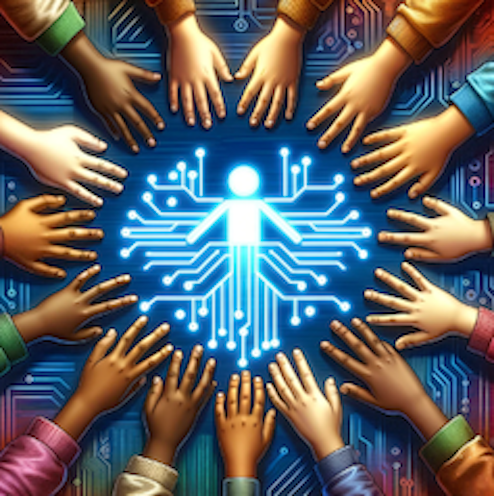Voices of Inclusion: My Love Affair with AI - Thoughts on Its Potential and Responsible Use

By Maria Victoria Diaz, PhD
In the last four years, I have been immersed in the world of AI, both professionally and personally. Not a single day goes by without me using, exploring, or testing a new AI-powered tool. My colleagues and friends often jokingly ask me, "What have you learned this week about your best friend, AI?"
Just yesterday, I experienced the power of AI firsthand. With a few clicks and some hours of work, I wrote lyrics for a song, and with my AI friend, we created the music, arrangements, and singing of an incredible jazzy melody (follow this link if intrigued by the result). This experience reinforced my belief in AI's ability to democratize access to creative tools and empower individuals to express themselves in new ways.
The Power of AI for Inclusion
The most amazing contribution of AI, in my opinion, is its ability to customize and adapt conversations, resources, technologies, texts, audios, and videos to serve traditionally underserved individuals. AI facilitates communication and includes everyone as part of the constituency to be served by any tool or development, bringing us closer to the concept of Universal Design than ever before. This is why I am a little obsessed with using AI every day. We can now dream of inclusive classrooms, educational resources, and overcoming communication and language barriers. Our Latino communities, children with disabilities, teachers, and parents can finally be part of the conversation with tools and resources designed using AI under the framework of Universal Design.
One of the most promising applications of AI for inclusion is in the education of English learners with disabilities. For example, AI-powered language translation tools can help parents and teachers of English language learners communicate and fully collaborate to support the students. By providing real-time text-to-speech or speech-to-text lectures, easy reading conversion of instructional materials, and class discussions, these tools can break down barriers, ensure all students have equal access to learning opportunities, and help students with disabilities engage with course content and communicate their ideas more effectively. Customizing tools to serve low-incidence disabilities, for me, with no doubts, is the power of AI.
The Ethical Challenge
Is using AI dangerous? Like any technology, from the invention of the pencil until now, AI can be used for good or bad. The choice is yours. The responsible use of technology has always been an ethical challenge we must face. As we embrace AI, we must develop guidelines and principles to ensure it is used ethically and responsibly. This includes protecting privacy, promoting transparency, and preventing AI from being used to discriminate or cause harm.
Don't feel threatened; you just need to readjust, adapt, and embrace the new technology. It's crucial to recognize that the promise of AI is to help and enhance current structures, not to crash them or replace them entirely without human control. AI should be seen as a tool to support and empower humans, not as a substitute for human judgment, creativity, and decision-making. As we integrate AI into various industries and domains, we must strive to find the right balance between leveraging AI's capabilities and maintaining human oversight and control. By doing so, we can harness the power of AI to improve efficiency, productivity, and innovation while ensuring that we-humans remain at the center of the process.
The Cost of AI
Some may wonder if all these new AI-based tools are free or cheap. In my experience, AI helps us optimize processes and increase capabilities, but it is not a magic wand without the wizards behind it. For example, our company now offers a dubbing service that has reduced costs by almost 40% and increased our capabilities and timelines by more than 130% thanks to AI. However, we still receive calls asking for a mere 10% of the initial cost of the service. It's essential to understand that AI is a tool to enhance and optimize, not a way to drastically cut costs without considering the human expertise and effort involved and the new investments in development, training, and integration that comes related to including AI in the production workflow. You can rethink ways to work, design new services, and increase capabilities, but AI came to support, help, and allow new resources we didn't have before. Whoever thinks of replacing their teams with AI assistants or lowering their budgets to use free or cheap tools is missing the point.
This morning, I told my daughter that using AI is not cheating. If you have the right question and can process, debate, and learn from the answers, AI is just another tool to support your learning experience, like any other.
AI has the potential to revolutionize the way we work, learn, and interact with one another. By embracing its power for inclusion, using it responsibly, and understanding its true value, we can harness AI to create a better future for all. The key is to approach AI with an open mind, adapt to the changes it brings, and always keep learning.
As we move forward with AI, let us not forget to ask ourselves: How can we ensure that AI benefits everyone? What role can each of us play in shaping an inclusive, ethical, and responsible AI-powered future? The answers to these questions will determine the course of our collective journey with this transformative technology.
